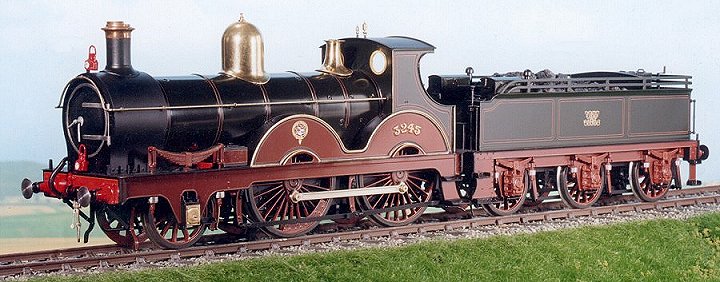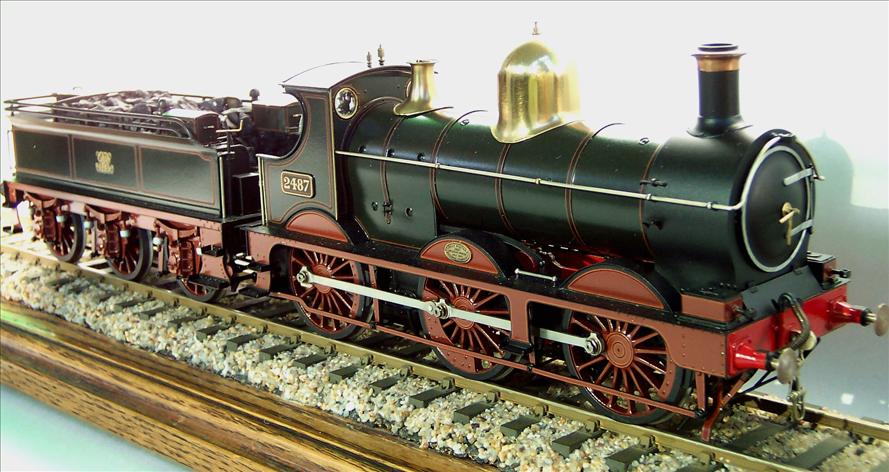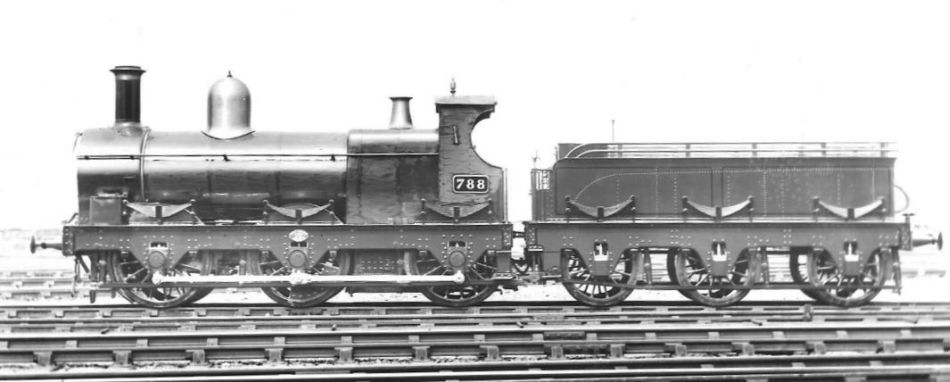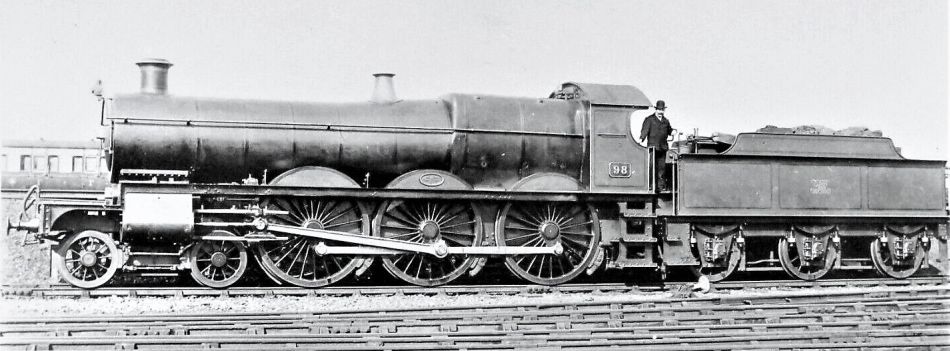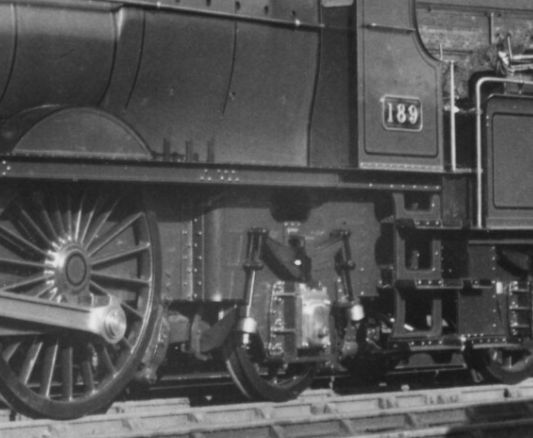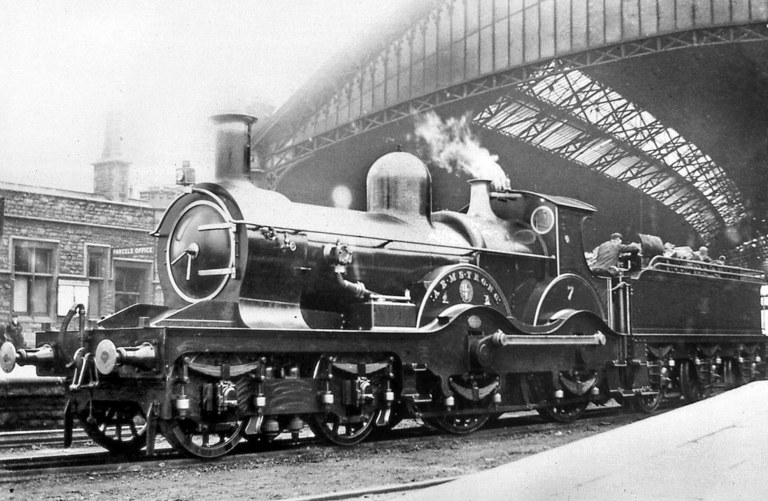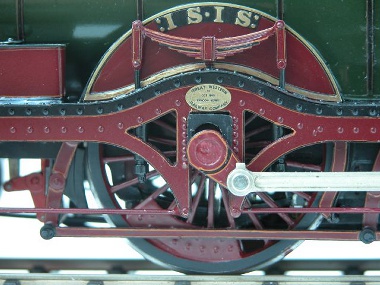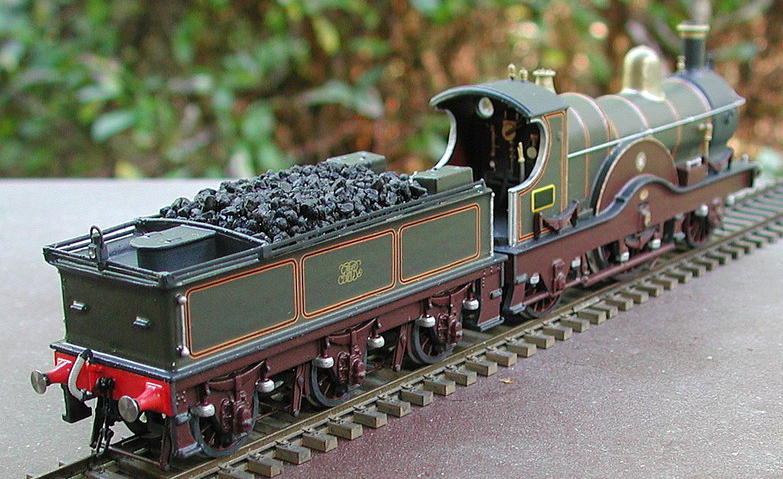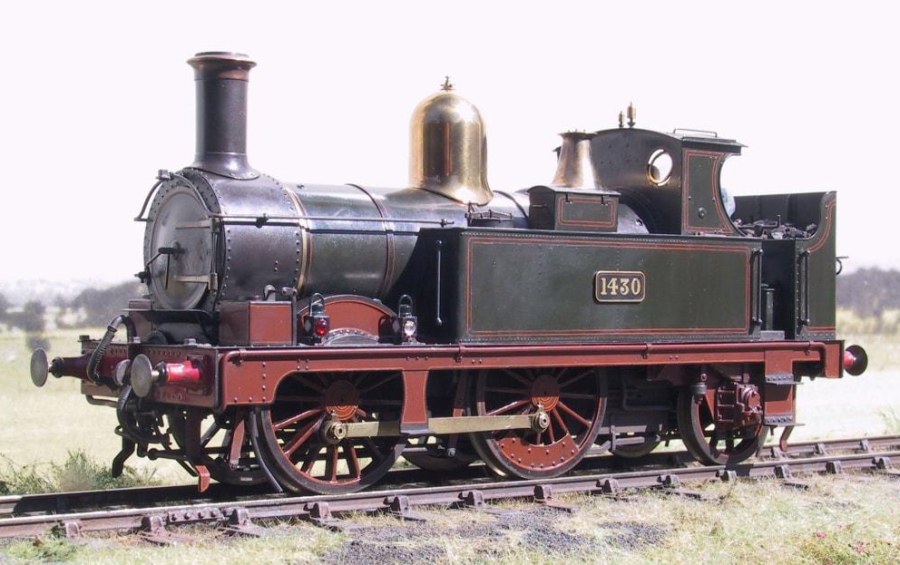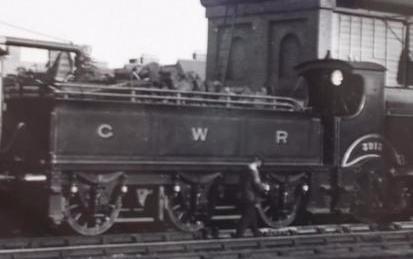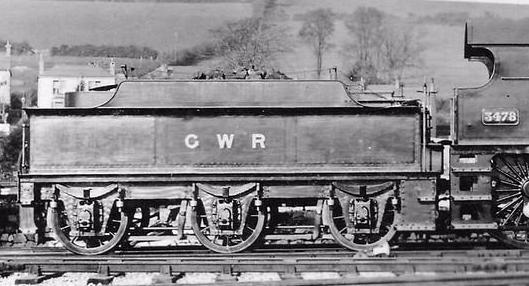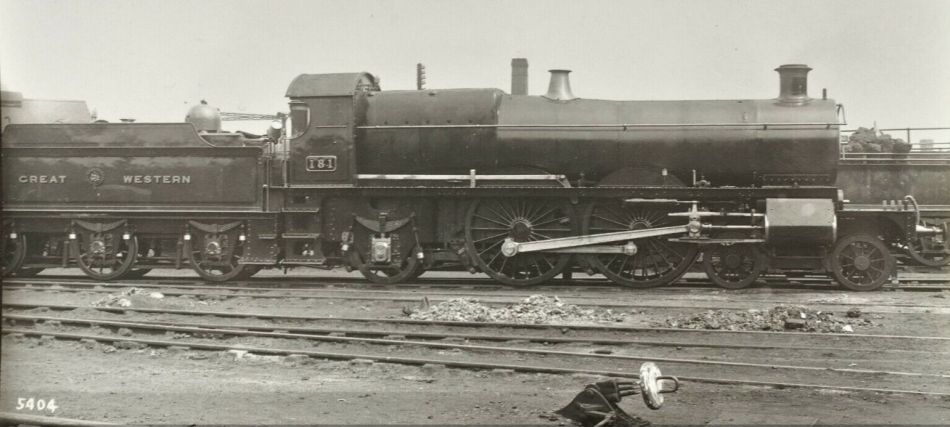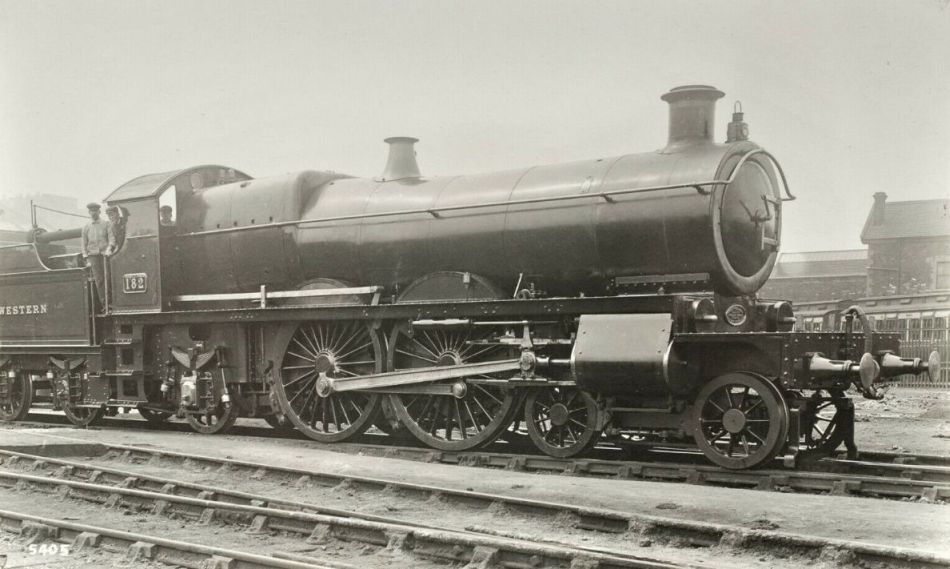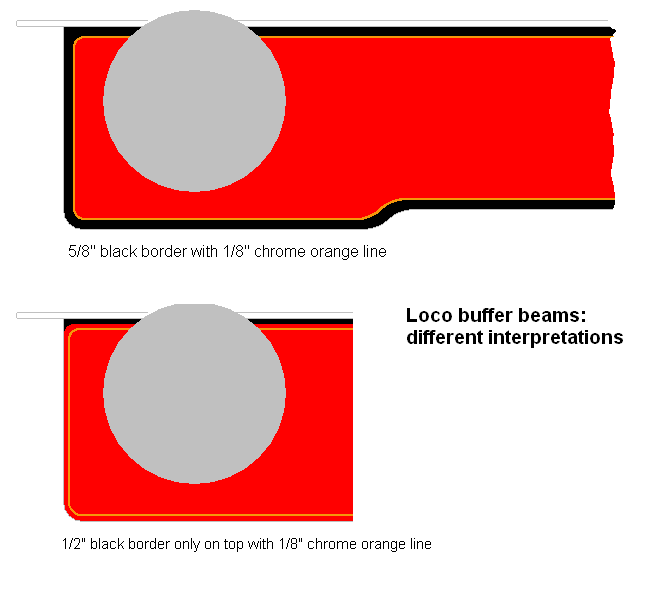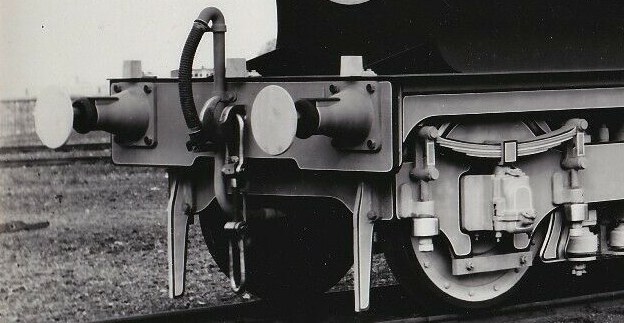| Section Page | Previous Page | Next Page |
GWR 1900–1906 loco livery
With the exception of some detail differences, the livery carried by locos from 1900–1906 followed closely the overall style introduced from around 1894, when the standard Middle Chrome Green was introduced for the body colour. Throughout the 1900–1906 era, considerable change took place to the applied colour schemes, particularly in respect to frames, springs and wheels, and transitional changes were adopted prior to their formalisation in the 1906 scheme. Wheel spokes and hubs, splasher fronts and the outer surface of outside frames (and hanging bars) were in Indian Red (or shades thereof, Great Western Way describing them as 'purple-brown'), with full lining throughout. Wheel tyres were black. The colour of the outer face of inside frames is not mentioned in any GWR literature. Whilst black is assumed to have been used for goods locos and non-express passenger locos, the outer face of inside frames on the early Churchward inside-framed express passenger locos is a bit of a mystery. Of these locos, 100 (built February 1902), 98 (built March 1903), the Scott Atlantics 171–190 (built February to September 1905, although 171 appeared considerably earlier, in December 1903), and 40 (built May 1906) seem to have received Indian Red on their outer frame faces. The first batch of County 4-4-0s (of 1904), the first set of County Tanks (of 1905) and the first 'Lady' series 2901–10 of the Saints (built May 1906) seem to have received black on their outer frame faces. The Birdcage tanks (of 1902–3) and the first Prairies probably had black outer frame faces. The brass dome, brass safety valve, brass whistles, brass splasher rims 1, brass vertical cabside beadings, cabfront brass window surrounds and the chimney's copper cap were fully polished, as was any beading at the junction of boiler and smokebox. Buffer beams, buffer stocks (except for their top steps, which were black) and the inner faces of inside frames were in China Red (vermilion). Footplate, splasher tops, smokebox and cab roof, and the outer faces of inside frames, were black. Insides of cabs were body-colour green. Buffer heads, handrails, smokebox door rims and their hinges and dart handles were polished steel, as were the spring shackle cups on carrying and tender wheels. Coal rails on tenders were black. The bodies of loco lamps were black until 1903/4, thereafter they were red (the red being assumed to be vermilion). Tank locos followed the same painting and finishing style, with fully lined boiler, tanks and bunker, but they did not carry the monogram or any indication (other than a works plate fitted on the rear of the bunker) of GWR ownership. Tops of side tanks were black. Number plates were placed in the centre of the side tank, or on cabsides for saddle tanks. Number plates on the larger tank engines were sometimes moved to the bunker side when larger bunkers were fitted. From 1902, changes to the above scheme began to appear on goods engines. Springs, both below and above the footplate, and their spring shackles, on both locos and tenders, began to be painted black rather than Indian Red, and from 1903/4, it would appear that splasher fronts above the footplate started to appear in green rather than Indian Red. On goods locos and tanks, it seems that brass splasher beading was painted over, probably in black (to match the splasher tops). The evidence for some of these transitional livery aspects is sketchy, and it is unlikely they were applied consistently to all newly painted or repainted locos, until their formal adoption in 1906. In October 1903, an experimental livery of all-over black with red lining was applied to 102, the first of the de Glehn Atlantics, but the loco was repainted in standard express loco green livery in 1905. RCTS states that 97, the prototype 2-8-0, was also outshopped in black, but contemporary evidence indicates otherwise 2. The November 1905 issue of the Great Western Railway Magazine notes there was a repeat of the experimental black and red lining scheme applied to one of the new 2800 class locos 2802–5 in September–October of that year. (It is not known which loco was involved.) Steel dome casings were introduced in 1904, which were painted in bodywork green, and brass dome covers began to be painted over from 1904. (The Railway Magazine belatedly reported the painting over of domes in October 1906.) From mid-1905 the GWR monogram seen on the '3-panel' tender was replaced with the garter crest, located between the words 'GREAT WESTERN', with the lining on tender sides being simplified to a single panel rather than the three shown in the picture above. The style changeover date was probably between April and July 1905. It seems that some locos were however being shopped with '3-panel' tenders up to late 1905. The tender for the final de Glehn Atlantic, 104, appeared with the crest in the middle of a '3-panel' arrangement. Lining on many goods locos began to cease from 1904/5 onward. Repainting of goods locos passing through the works was often confined to those parts of the loco that had been repaired or modified. This reduction of cosmetic treatment reflected the large number of locos that were being upgraded and modified during this period. The dedicated paint shop at Swindon was closed to make way for more erecting space, and all loco painting thereafter was carried out in the erecting shops. 1 The situation on the polishing of splasher rims before 1903 for goods and tank engines is not clear, and it is possible only some passenger engine classes were polished. Splasher rims on some 4-6-0 express passenger locos prior to 1906 were painted, and polishing seems to have begun at some stage after 1906. Dated pictures should be consulted on this matter.
Regarding the shade of the colour used on outside frames, the following pictures show a colour darker than a usual modern interpretation of 'Indian red', and much closer to a 'purple-brown':
Bufferbeam lining
The Locomotive Volume 1, No. 3, March 1896 states: "The engines of the Great Western Railway are painted chrome green, the shades varying with the works at which the engine was constructed. Express and passenger engines built at Swindon are painted a lighter green than the goods and tank engines turned out of the same shops while engines from Wolverhampton assume quite a blue green. The striping of the engines also differ, Swindon engines having a black band of medium width a very fine yellow line on either side, but Wolverhampton engines a fine white line in place of the yellow. The framing and splashers of all engines are a dark red brown, edged round with, a narrow black border with a fine yellow line inside it. The domes and safety valve casings are bright brass, as also is the chimney top; this latter on Swindon-built engines in of a bell-top pattern whereas Wolverhampton engines have a moulded top. The buffer beams are vermillion edged round black and fine yellow line. The interior of the cabs is painted vermillion to about the height of the splashers, then green above, edged round with black and fine yellow line. Altogether the G.W. Railway engines are handsomely painted, and being kept very clean always boast of an imposing appearance. The splashers of the 3001 class of single bogie express engines are further decorated with the arms of the G.W. Railway surrounded by a garter cast in relief and maintained in true Heraldic fashion, and on either side of this the crests of London and Bristol respectively, also in relief. On other express engines the coat of arms is "transferred" on the driving splasher. Number plates are of brass, raised figures, with a background of black with fine yellow line round the inside." |
||||||||||||||||
| Section Page | Previous Page | Next Page |
